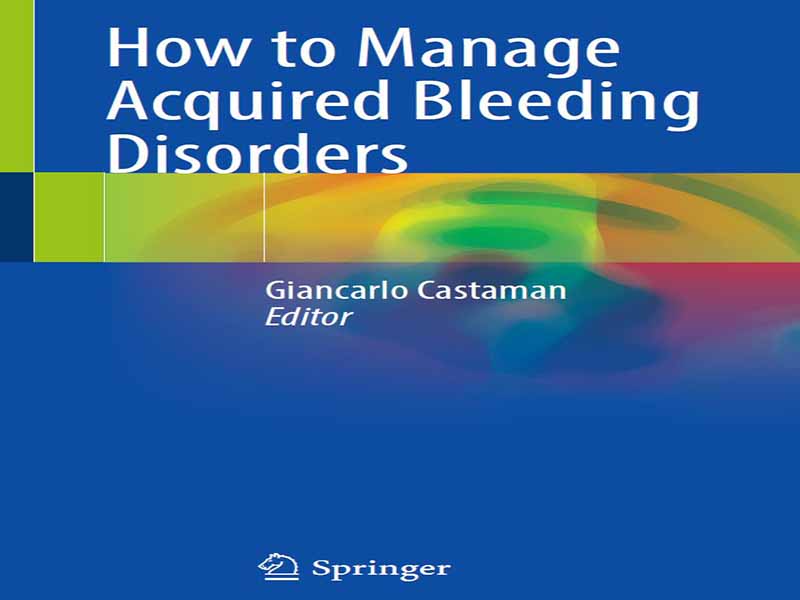- عنوان کتاب: How to Manage Acquired Bleeding Disorders
- نویسنده: Giancarlo Castaman
- حوزه: خونریزی
- سال انتشار: 2025
- تعداد صفحه: 217
- زبان اصلی: انگلیسی
- نوع فایل: pdf
- حجم فایل: 7.82 مگابایت
خونریزی در زمان مراجعه یا در طول دوره بالینی یک بیماری، اغلب یک عامل نگرانکننده یا وضعیت اضطراری بوده است. شناسایی علت و مدیریت آن ممکن است نیاز به روشهای تشخیصی اورژانسی و نیاز به مشاوره خاص برای تشخیص مناسب و مدیریت علائم داشته باشد. آگاهی از مکانیسمهای اصلی زیربنایی فرآیند انعقاد، برای درک صحیح لحظات مختلفی که این مکانیسمها میتوانند تغییر کنند و عواقب و اقدامات درمانی آنها، اساسی است. در کنار شناختهشدهترین بیماریهای مادرزادی که با وقایع خونریزیدهنده مرتبط هستند و اغلب در اوایل کودکی بروز میکنند (هموفیلی، بیماری فون ویلبراند و…)، شرایط بالینی بسیار شایعتری وجود دارد که شامل چندین شاخه پزشکی در سراسر جهان میشود. اکنون به خوبی درک شده است که چگونه استفاده از داروهای ضد ترومبوتیک یا ضد پلاکت میتواند با وقایع خونریزیدهنده، حتی شدید، که نیاز به مداخلات درمانی به موقع و فردی دارند، پیچیده شود. خطر خونریزی مرتبط با بیماریهای نسبتاً شایع مانند بیماری کبد، انعقاد داخل عروقی منتشر و لوسمی حاد باید همیشه به عنوان یکی از علائم بالقوهای که میتواند زندگی بیمار را به خطر بیندازد، در نظر گرفته شود. اختلال انعقادی ناشی از تروما در سالهای اخیر توجه زیادی را به خود جلب کرده است و عوامل پیشآگهی را برای نتیجه بالینی بهتر شناسایی کرده و بر اهمیت درمان فوری هموستاتیک تأکید دارد. بدیهی است که خطر خونریزی مرتبط با شرایط خاصتر خونشناسی، مانند ترومبوسیتوپنی ایمنی، هموفیلی اکتسابی و بیماری فون ویلبراند اکتسابی، نباید نادیده گرفته شود، که در آن گاهی اوقات تأخیر در تشخیص میتواند بر خطر و سیر نامطلوب علائم خونریزی تأثیر بگذارد. در نهایت، مدیریت رویداد خونریزی در دوران بارداری یا زایمان گاهی اوقات میتواند به معنای یک اورژانس واقعی باشد که اغلب نیاز به یک رویکرد چند رشتهای هماهنگ دارد. همه این مباحث در این کتاب توسط همکارانی با ارزش شناخته شده در موضوع خاص اختصاص داده شده به آنها بررسی شده است. فصلها بیش از هر چیز سعی کردهاند تا رویکردی عملی به مدیریت رویداد خاص ارائه دهند تا نه تنها نیازهای همکاران درگیر، بلکه متخصصان جوان در حال آموزش در چندین شاخه پزشکی را نیز برآورده کند. ضمن تشکر از همه نویسندگان همکار به خاطر مشارکت عالیشان، امیدواریم که این متن بتواند در مواقع ضروری مفید و سریع باشد.
Bleeding event at the presentation or during the clinical course of a disease has often been an element of concern or emergency situation. Identifying the cause and managing it may require emergency diagnostic procedures and the need for specific counselling for appropriate diagnosis and symptom management. Knowledge of the main mechanisms underlying the coagulation process remains fundamental to correctly understanding the various moments in which these mechanisms can be altered and their consequences and therapeutic measures. Alongside the most well-known congenital diseases that are associated with haemorrhagic events, often already manifested in early childhood (haemophilia, von Willebrand disease,…), there are much more frequent clinical conditions that involve several branches of medicine across the board. It is now well appreciated how the use of antithrombotic or antiplatelet drugs can be complicated with haemorrhagic events, even severe, which require timely and individualized therapeutic interventions. The bleeding risk associated with relatively frequent diseases such as liver disease, disseminated intravascular coagulation and acute leukaemia must always be considered as one of the potential symptoms that can endanger the patient’s life. Trauma coagulopathy has received a lot of attention in recent years, identifying prognostic factors for a better clinical outcome, emphasizing the importance of urgent haemostatic treatment. Obviously, the haemorrhagic risk associated with more specific haematological situations, such as immune thrombocytopenia, acquired haemophilia and acquired von Willebrand disease, should not be overlooked, in which sometimes the diagnostic delay can weigh on the risk and unfortunate evolution for the haemorrhagic symptom. Finally, the management of the haemorrhagic event during pregnancy or childbirth can sometimes take on the connotations of a true emergency, which often requires a coordinated multidisciplinary approach. All these topics are dealt with in this book by colleagues of well-recognized value in the specific theme assigned to them. The chapters have above all tried to give a practical slant of management of the specific event to meet the needs not only of the colleagues involved but also of the young specialists in training in several branches of medicine. In thanking all the co-authors for their excellent contribution, our hope is that the text can be of useful and quick help in chaos of need.
این کتاب را میتوانید از لینک زیر بصورت رایگان دانلود کنید:



































نظرات کاربران